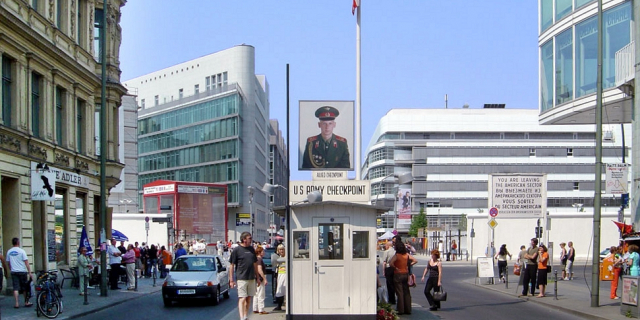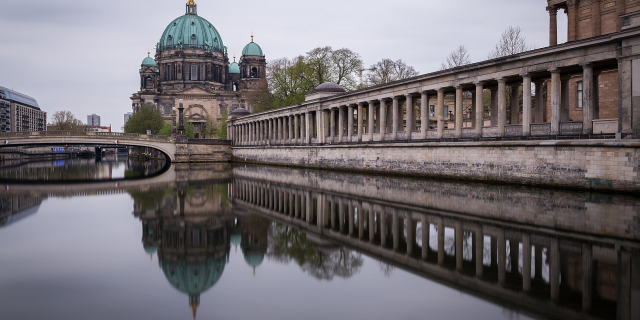The Topography of Terror (German: Topographie des Terrors) is an outdoor and indoor history museum in Berlin, Germany. It is located on Niederkirchnerstrasse, formerly Prinz-Albrecht-Strasse, on the site of buildings, which during the Nazi regime from 1933 to 1945 was the SS Reich Security Main Office, the headquarters of the Sicherheitspolizei, SD, Einsatzgruppen and Gestapo.
The buildings that housed the Gestapo and SS headquarters were largely destroyed by Allied bombing during early 1945 and the ruins demolished after the war. The boundary between the American and Soviet zones of occupation in Berlin ran along the Prinz-Albrecht-Strasse, so the street soon became a fortified boundary, and the Berlin Wall ran along the south side of the street, renamed Niederkirchnerstrasse, from 1961 to 1989. The wall here was never demolished. The section adjacent to the Topography of Terror site is the longest extant segment of the ...Read more
The Topography of Terror (German: Topographie des Terrors) is an outdoor and indoor history museum in Berlin, Germany. It is located on Niederkirchnerstrasse, formerly Prinz-Albrecht-Strasse, on the site of buildings, which during the Nazi regime from 1933 to 1945 was the SS Reich Security Main Office, the headquarters of the Sicherheitspolizei, SD, Einsatzgruppen and Gestapo.
The buildings that housed the Gestapo and SS headquarters were largely destroyed by Allied bombing during early 1945 and the ruins demolished after the war. The boundary between the American and Soviet zones of occupation in Berlin ran along the Prinz-Albrecht-Strasse, so the street soon became a fortified boundary, and the Berlin Wall ran along the south side of the street, renamed Niederkirchnerstrasse, from 1961 to 1989. The wall here was never demolished. The section adjacent to the Topography of Terror site is the longest extant segment of the outer wall, as the longer East Side Gallery section in Friedrichshain was part of the inner wall, not visible from West Berlin.
The first exhibitions of the site took place in 1987, as part of Berlin's 750th anniversary. The cellar of the Gestapo headquarters, where many political prisoners were tortured and executed, was found and excavated. The site was then turned into a memorial and museum, in the open air but protected from the elements by a canopy, detailing the history of repression under the Nazis. The excavation took place in cooperation with East German researchers, and a joint exhibition was shown both at the site and in East Germany in 1989.
In 1992, two years after German reunification, a foundation was established to take care of the site, and the following year, it initiated an architectural competition to design a permanent museum. A design by architect Peter Zumthor was chosen. However, construction was stopped due to funding problems after the concrete core of the structure had been built. This stood on the site for nearly a decade until it was finally demolished in 2004 and a new building begun.
The construction of the new Documentation Centre according to a prize-winning design by the architect Ursula Wilms (Heinle, Wischer und Partner, Berlin) and the landscape architect Heinz W. Hallmann (Aachen) was finished in 2010. The new Documentation Centre was officially opened on 6 May 2010 by Federal President Horst Köhler on the occasion of the 65th anniversary of the end of World War II. The new exhibition and documentation building and the redesigned historic grounds were opened to the public on 7 May 2010.
After the demolition of the ruins in the 1950s, the area was used as a bumper car site and a dumping ground for rubble from the renovation of Kreuzberg. The plans for a memorial site on the former site of the Gestapo goes back to 1978, when Berlin architecture critic Dieter Hoffmann-Axthelm was one of the first to note, in essays and surveys, the significance of the former site of the Gestapo, SD and RSHA headquarters.
The first exhibition on the site's history was created for the 750th anniversary of Berlin in 1987. The research continued after it, leading to a documentation centre that collected some more evidence for the terror of the National Socialists in Germany. In 1992, a foundation was created for the construction and maintenance of the centre with an associated permanent exhibition. The managing director is Rabbi Andreas Nachama.
A tender in 1993 to design the museum complex was won by the Pritzker Prize-winning Swiss architect Peter Zumthor. Based on the temporary exhibition building, his design was likened to the skeleton of a barracks, allowing light through the glazed gaps in the concrete beams. Although critically acclaimed, the structure proved expensive to build and when the original contractor became insolvent in the middle of construction, no other contractor willing to continue the project for the fixed fee could be found. With the city of Berlin unwilling to pay an additional three to five million Euros for a reduced design and funding from the federal government delayed until more progress was achieved, the site was left with just the concrete stairwells of the design. Having spent 13.9 million Euros already, these were demolished, despite the protests of Zumthor and other architects, in 2004.[1]
Architectural design competition 2005 Part of the Topography of Terror museum. The preserved section of the Berlin Wall can be seen at the top of the picture, 2006
Part of the Topography of Terror museum. The preserved section of the Berlin Wall can be seen at the top of the picture, 2006In June 2005 a new architectural design competition was launched following the aborted partial construction of Zumthor's design. Out of 309 submitted and 23 chosen drafts, architect Ursula Wilms from the Berlin architects office Heinle, Wischer and Partner and landscape architect Heinz W. Hallmann from Aachen won in January 2006 the final round. The draft included a two-storey, ashlar-formed, paned building with an available surface of 3,500 square metres. For the construction around €15 million was available. Another five to nine million Euro was used for the interior and the redevelopment of the historical site. These costs were defrayed jointly by both the federal government and the federal state of Berlin, each contributing 50%. The architects estimated construction costs at a maximum of €20 million and a construction period of two years.
The construction was finished on time and the new building was opened to the public on 7 May 2010.
BuildingThe open-air exhibition in the trench alongside the excavated segments of cellar wall on Niederkirchnerstraße (formerly Prinz-Albrecht-Straße) was retained and sheltered with glass. The room for the permanent exhibition is 800 cubic metres and presents the development and functions of the security apparatuses during the Nazi regime. A room for events at the back of the building can accommodate 200 participants. In the southern part of the area outside is a copse of black locust trees, the remains of "Harrys Autodrom" from the 1970s, whereas the rest of the open space is covered with greywacke. Around the flat-roofed building is a façade made of metal lamellae, which opens the building in a way that it is possible to look out of it to the surroundings anywhere on the ground floor of the building. In the basement is the seminar centre, the library with about 25,000 volumes, the memorial department and offices for 17 employees of the Topography of Terror Foundation.































Add new comment